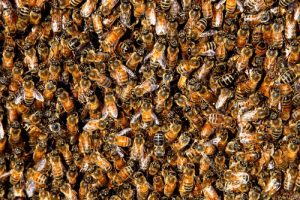How to Deal with a Honey Bee Swarm
By Chris Williams on February 23, 2012.
Q. Last summer at my son’s elementary school, there was a large bee swarm on a tree at the edge of the playground. You could barely see the trunk of the tree it was so covered with bees. What can you do about a swarm like that? I never did hear how they got rid of the bees.
A. First thing to do if you come across a honey bee swarm, is don’t panic. Honey bee swarms are very docile unless the bees are threatened. Honey bee swarms are a good thing because we rely on honey bees to pollinate our food crops. Honey bees in the U.S. have been severely reduced in recent years because of disease, parasites, and other unknown reasons. Colonies are dying out and we need to do whatever we can to preserve our remaining honey bees.
 A honey bee swarm is a compact ball of bees, ranging in size from a grapefruit to a basketball, usually hanging from a tree or bush, or sometimes on the side of a building. Honey bee swarms are a natural occurrence in spring and early summer. The bees leave the hive in a large group when the hive becomes overcrowded. In most areas, swarming occurs from May into July, with the earliest swarms being the largest.
A honey bee swarm is a compact ball of bees, ranging in size from a grapefruit to a basketball, usually hanging from a tree or bush, or sometimes on the side of a building. Honey bee swarms are a natural occurrence in spring and early summer. The bees leave the hive in a large group when the hive becomes overcrowded. In most areas, swarming occurs from May into July, with the earliest swarms being the largest.
This is what you should do when dealing with a honey bee swarm:
- If possible, do nothing. Honey bee swarms will soon disperse if left alone. A swarm is obviously more of a concern if it is in a traffic area—in front of a door, or where children or pets will cross its path. In the case of the schoolyard, removal of the swarm is probably a good idea.
- Do not spray pesticide on the swarm or attempt to remove it yourself. Contact a pest control company or your county Cooperative Extension Service. They probably have a relationship with a local beekeeper who would be happy to remove the swarm. Beekeepers are trained to collect honey bee swarms and relocate them to new hives where they can go about their business of pollinating plants and making honey.
- If the swarm is located in a building wall or ceiling void, the removal is a little bit more complicated and may involve cutting into walls.
- People are often scared of bees because they confuse them with the more aggressive yellowjackets. There is also a lot of scary media hype about the Africanized (“killer”) bees. Africanized bees are actually established in very few states, and do not occur in the Northeast at all. Beekeepers in states with Africanized bees know how to handle and remove them.